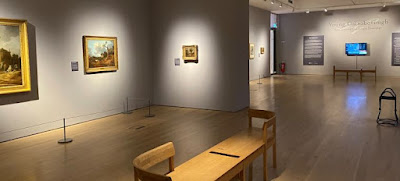In 2017 Lindsay Stainton discovered that an album of 25 drawings in the Royal Collection were the work of the young Thomas Gainsborough. They are currently on show at York Art Gallery. These views may have been influenced by Dutch painting but they also reflect a deep engagement with the patterns and shapes of trees and paths near Gainsborough's home. I particularly enjoyed seeing his experimentation with different techniques. In the example below, he uses black and white chalk, sharpened and held in a porte-crayon. The curators note that 'he blended the chalks into the paper with a wad of tightly rolled leather, called stump, to create smoother tones and more subtle light effects. He employs this technique extensively to depict the soft outlines of the clouds and the misty pool.' In a finished painting (above) you still feel he's experimenting with ways of animating a simple view, with hazy light through mobile clouds creating interesting effects in every turn of the road and slope of the dunes.
It was a pleasure to leave the congested streets of York for the tranquillity of this exhibition, with its peaceful wooded vistas only occasionally interrupted by a distant figure or a donkey. In addition to the Gainsboroughs the exhibition includes a video installation, Clay, Peat, Cage (2015) by Jade Montserrat and Webb-Ellis, described as 'a contemporary counterpart to Gainsborough’s landscape practice.' Gainsborough mentally immersed himself in the details of his local woods and heathland. In 'Clay' Montserrat physically immerses herself in the soil, squatting naked, digging and smearing herself with earth. 'Clay' also provides a thematic link to the ceramics on display upstairs, which have become a speciality of the museum. If you are near York I would recommend popping in as you may have the exhibition almost to yourself as I did (see photo below). And Gainsborough's landscapes are a great tonic for the spirit in these difficult days. As John Constable once said, 'on looking at them, we find tears in our eyes and know not what brings them.'



2 comments:
"In 'Clay' Montserrat physically immerses herself in the soil, squatting naked, digging and smearing herself with earth."
Once, this would have been a rather reactionary parody of "contemporary art". Now, not so much.
Mike
I was going to mention some of the theoretical background to 'Clay', referred to here - Josephine Baker, slavery, the Brontës, land ownership and the ecology of peat bogs. Certainly feels like quite a leap from Gainsborough's sketching excursions.
Post a Comment